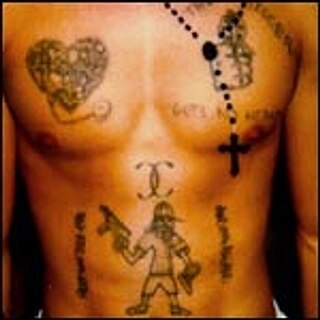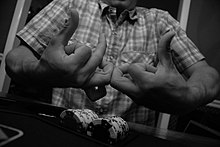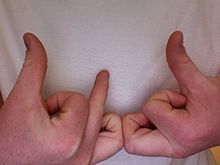A gang is a group or society of associates, friends, or members of a family with a defined leadership and internal organization that identifies with or claims control over territory in a community and engages, either individually or collectively, in illegal, and possibly violent, behavior, with such behavior often constituting a form of organized crime.

The 18th Street Gang, also known as Calle 18, Barrio 18, Mara 18, or simply 18 in North America, is a multi-ethnic transnational criminal organization that started as a street gang in Los Angeles. It is one of the largest transnational criminal gangs in Los Angeles, with 30,000-50,000 members between the United States, Mexico, and Central America and is also allied with the Mexican Mafia, another US-based crime organization. A United States Department of Justice report featured the following statement regarding 18th Street and rival gang MS-13, "These two gangs have turned the Central American northern triangle into the area with the highest homicide rate in the world."

Raymond Lee Washington was an American gangster, known as the founder of the Crips gang in Los Angeles. Washington formed the Crips as a minor street gang in the late 1960s in South Los Angeles, becoming a prominent local crime boss. In 1971, Washington formed an alliance with Stanley "Tookie" Williams, establishing the Crips as the first major African-American street gang in Los Angeles, and served as one of the co-leaders. In 1974, Washington was convicted of robbery and received a five-year prison sentence, during which his leadership and influence in the Crips declined.

The Mexican Mafia, also known as La eMe, is a Mexican American criminal organization in the United States. Despite its name, the Mexican Mafia has no origins in Mexico, and is entirely a U.S. criminal prison organization. Law enforcement officials report that the Mexican Mafia is the deadliest and most powerful gang within the California prison system.

The Rollin 60s Neighborhood Crips is a street gang based in Los Angeles, California, originally formed in Los Angeles in 1976 from the Westside Crips and having since spread to other cities in the United States. Membership is estimated to be around 1,600 people, making it one of the largest gangs in the Los Angeles area.

The Crips are an alliance of street gangs that is based in the coastal regions of Southern California. Founded in Los Angeles, California, in 1969, mainly by Raymond Washington and Stanley Williams, the Crips began as an alliance between two autonomous gangs, and developed into a loosely connected network of individual "sets", often engaged in open warfare with one another. Its members have traditionally worn blue clothing since around 1973.
The Jungles faction of the Black P. Stones street gang is a division ("set") of the Bloods gang alliance in Los Angeles. Originating in Los Angeles' Baldwin Village neighborhood in the 1960s, the Black P. Stones became one of the largest gangs in the city. The gang has been linked to various crimes, including murders, assaults, robberies, narcotics violations and firearms violations, and has been the subject of numerous FBI and LAPD investigations.
About one to two percent of United States Armed Forces members are estimated to belong to criminal gangs in the United States, a much higher proportion than in the civilian population.
In the late 19th and early 20th centuries, African American organized crime emerged following the first and second large-scale migration of African Americans from the Southern United States to major cities of the Northeast, Midwest, and later the West Coast. In many of these newly established communities and neighborhoods, criminal activities such as illegal gambling, speakeasies and were seen in the post-World War I and Prohibition eras. Although the majority of these businesses in African American neighborhoods were operated by African Americans, it is often unclear the extent to which these operations were run independently of the larger criminal organizations of the time.

The Pirus are a subset of the larger Bloods gang alliance, an organized crime group in the United States.
Bloods & Crips was an American gangsta rap group from Los Angeles County mostly known for their record selling song "Piru Love".
The United Blood Nation, also known as the East Coast Bloods, is a street and prison gang active primarily in the New York metropolitan area. It is the east coast faction of the California-based Bloods street gang. Their main source of income is the trafficking and sale of illegal drugs.
The Rollin' 30s Harlem Crips are a faction, or "set", of the Crips alliance of street gangs. The gang was formed by Belizean American Crips who had moved from South Los Angeles to Belize and then to Harlem, New York.
The Nine Trey Gangster Bloods or Nine Trey Gangsta Bloods (NTG) are a violent set of the United Blood Nation street gang, which is itself a set of the Bloods gang. The gang operates on the East Coast of the United States.
Houston's murder rate in 2005 ranked 46th of U.S. cities with a population over 250,000 in 2005. In 2010, the city's murder rate was ranked sixth among U.S. cities with a population of over 750,000 according to the Federal Bureau of Investigation (FBI). Houston had over 400 homicides in 2020 and 473 by the end of December in 2021 a predicted increase of 30% year on year.

The East Side Mob Piru are a "set" of the Piru gang alliance, which is itself part of the larger Bloods alliance. Suge Knight, the co-founder and former CEO of Death Row Records, is an affiliate.

The Crenshaw Mafia are a "set" of the Bloods gang alliance. The gang are depicted in several movies including Boyz n the Hood and Straight Outta Compton.
The Crips and the Bloods, two street gangs founded in Los Angeles, California, have been in a gang war since the 1970s. The war is made up of smaller, local conflicts perpetrated by chapters of both gangs, and has mostly taken place in major cities in the United States, especially Los Angeles (L.A.). It is also present in other countries, including Belize. The gangs often identify themselves using clothing colored blue for Crips, and red for Bloods; people wearing those colors in gang territory are often targets of violence.









